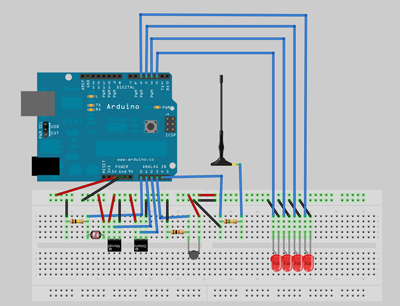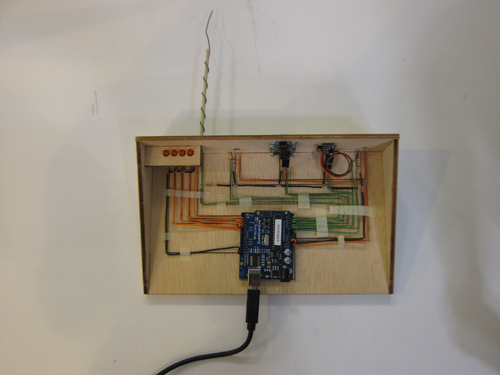Difference between revisions of "Urban sensor kit"
| (16 intermediate revisions by 4 users not shown) | |||
| Line 1: | Line 1: | ||
| + | [[Category:Projects]] | ||
| + | |||
=Version 1:= | =Version 1:= | ||
Credits: Felipe Pecegueiro do Amaral Curado, Oriol Carrasco, Alba Armengol Gasul, Luis E. Fraguada | Credits: Felipe Pecegueiro do Amaral Curado, Oriol Carrasco, Alba Armengol Gasul, Luis E. Fraguada | ||
| Line 33: | Line 35: | ||
* HiCap Li-ion Pack $47.36 + shipping: http://www.liquidware.com/shop/show/BP/Lithium+BackPack | * HiCap Li-ion Pack $47.36 + shipping: http://www.liquidware.com/shop/show/BP/Lithium+BackPack | ||
* 9v battery adapter for arduino: http://www.arduino.cc/playground/Learning/9VBatteryAdapter | * 9v battery adapter for arduino: http://www.arduino.cc/playground/Learning/9VBatteryAdapter | ||
| + | * Solar Shield - Bat. and Panel Not Inc. http://www.seeedstudio.com/depot/solar-charger-shield-p-594.html?cPath=104_107 | ||
==== Option 1: Custom Shield ==== | ==== Option 1: Custom Shield ==== | ||
| Line 83: | Line 86: | ||
==== Option 5 ==== | ==== Option 5 ==== | ||
| − | *Seeeduino Stalker (Arduino-compatible board + microSD datalog + xBee header | + | *Seeeduino Stalker (Arduino-compatible board + microSD datalog + xBee header + Battery connector / No usb, buy FTDI cable) http://www.seeedstudio.com/depot/seeeduino-stalker-atmega-328-p-600.html €27 |
**GPS Module http://www.cooking-hacks.com/index.php/gps-module-for-arduino.html €42 | **GPS Module http://www.cooking-hacks.com/index.php/gps-module-for-arduino.html €42 | ||
| − | **XBee 802.15.4 module | + | **XBee 802.15.4 module http://search.digikey.com/scripts/DkSearch/dksus.dll?Detail?name=XB24-AWI-001-ND €13 |
* TOTAL €85 (inc. arduino / no inc. serial-usb (ftdi) for programming) | * TOTAL €85 (inc. arduino / no inc. serial-usb (ftdi) for programming) | ||
* x5 = €425 | * x5 = €425 | ||
* Pros: Arduino Included. Small. | * Pros: Arduino Included. Small. | ||
* Cons: Serial connection (FTDI cables for programming) / MicroSD / International Shipping, more expensive | * Cons: Serial connection (FTDI cables for programming) / MicroSD / International Shipping, more expensive | ||
| − | |||
==== Option 6 ==== | ==== Option 6 ==== | ||
| Line 99: | Line 101: | ||
* TOTAL: €845 for 5 units | * TOTAL: €845 for 5 units | ||
| − | === 3. Additional Sensors | + | === 3. Additional Sensors=== |
| − | Libelium / Waspmote Sensors http://www.libelium.com/products/waspmote/sensors | + | ====Air Quality / Water Measurement==== |
| + | *Libelium / Waspmote Sensors http://www.libelium.com/products/waspmote/sensors | ||
| + | *Solder-less sensors add-ons http://www.seeedstudio.com/depot/electronic-brick-c-48.html (available at http://www.cooking-hacks.com/index.php/shop/arduino/eb-sensor-chassis-v1-1.html ) | ||
=== 4. Size / Packaging === | === 4. Size / Packaging === | ||
| Line 109: | Line 113: | ||
=== 6. Technical info Links === | === 6. Technical info Links === | ||
*[http://www.ladyada.net/make/xbee/modules.html XBee Know How by Ladyada] | *[http://www.ladyada.net/make/xbee/modules.html XBee Know How by Ladyada] | ||
| + | |||
| + | =Version 2:= | ||
| + | |||
| + | *Smart Geometry [http://www.buletintupperware.com/ tupperware april] [http://smartgeometry.org/index.php?option=com_community&view=groups&task=viewgroup&groupid=6&Itemid=0] | ||
| + | |||
| + | =Version 3:= | ||
| + | *Data tree (DIY Shields for Arduino) [http://academy.cba.mit.edu/labs/barcelona/areti.mark/DataTree/DataTree.html Data Tree, by Areti Markopoulou, Fab Academy 2011] | ||
| + | |||
| + | =Version 4:= | ||
| + | *Custom Arduino Shield. More info [[ASK Shield]] | ||
| + | |||
| + | |||
| + | |||
| + | =Sensor notes = | ||
| + | |||
| + | ==Sound sensor== | ||
| + | |||
| + | db son una unidad que mide la ratio entre una unidad de ref y una de entrada. además son una unidad logarítmica, su incremento no es lineal, esto es útil pq el rango de representación es muy grande | ||
| + | |||
| + | importante no liarse entre db's de potencia y db's de presión sonora http://en.wikipedia.org/wiki/Sound_pressure | ||
| + | |||
| + | para calcular los dB (dB así a secas es potencia o sea W) dB = 10 * Log (PowerInput/ PowerReference) | ||
| + | |||
| + | de momento yo he probado de calcular dBv... prueba el código y dime el que | ||
| + | |||
| + | int dBv = 20 * log(analogRead(A0) / 0.00378787879); // esto es dBv = 10 * Log (Vrms / Vrms referencia) // 0.00378787879 sale de considerar que 0dBv son 0.775V | ||
| + | |||
| + | también así a saco al igual podrías probar | ||
| + | |||
| + | int dBv = 20 * log(analogRead(A0) / calibration); | ||
| + | |||
| + | calibration saldría de comparar con el iphone… | ||
| + | |||
| + | ===para probar...=== | ||
| + | |||
| + | <code> | ||
| + | int cycles = 20; | ||
| + | long reads = 0; | ||
| + | int average = 0; | ||
| + | double dB = 0; | ||
| + | |||
| + | |||
| + | void setup() { | ||
| + | Serial.begin(9600); | ||
| + | } | ||
| + | |||
| + | void loop(){ | ||
| + | for (int i=0; i >= cycles; i++){ | ||
| + | reads = analogRead(A0) + reads; | ||
| + | } | ||
| + | average = reads / cycles; | ||
| + | reads = 0; | ||
| + | dB = 20*log10(average/250); | ||
| + | Serial.println(dB, DEC); | ||
| + | } | ||
| + | </code> | ||
| + | |||
| + | ---- | ||
| + | |||
| + | en principio el valor tendría que ser el valor RMS pero como no queremos medir una onda súper precisa sino ruido ambiental yo creo que podría funcionar a saco. | ||
| + | |||
| + | aun así medir dB directamente con el ADC por lo que he leído no es nada fácil pq en seguida te quedas o a 0 o te quedas saturado, 1023. estos se podría solucionar con un amplificador logarítmico algo que es como un op amp normal [http://buletinnews.com/ berita news] pero que en vez de amplificar la senyaseñall linealmente (como una multiplicación) la amplifica exponencialmente por lo que cuanto más pequeño es el número más resolución te da. | ||
| + | |||
| + | ---- | ||
| + | |||
| + | [http://mit.ocw.universia.net/6.101/NR/rdonlyres/Electrical-Engineering-and-Computer-Science/6-101Introductory-Analog-Electronics-LaboratoryFall2002/0F920C22-BEF2-47C4-A4BE-499279077036/0/decibels.pdf Articulo sobre calculo de decibelios] | ||
Latest revision as of 01:31, 17 January 2017
Contents
- 1 Version 1:
- 2 Goals for version 2
- 3 Version 2:
- 4 Version 3:
- 5 Version 4:
- 6 Sensor notes
Version 1:
Credits: Felipe Pecegueiro do Amaral Curado, Oriol Carrasco, Alba Armengol Gasul, Luis E. Fraguada Production Assistance: Fab Lab BCN
Parts List
- 1 x Arduino Deumilanove
- 1 x Light Sensor (Cadmium Sulfide Sensor, Light Dependent Resistor, Photocell)
- 1 x Sound Sensor
- 1 x Motion Sensor (Passive InfaredRed Sensor)
- 1 x Temperature Sensor
- 1 x Electromagnetism Sensor
- Wood Case (laser cut)
- Wire
- Resistors
 |
| Image:Felipe Pecegueiro do Amaral Curado |
Goals for version 2
1. Find sensors who’s data can be easily read and translated to useful units (sound sensor - dB)
2. Autonomy of kit: GPS Unit, On Board Data Logger, Battery
Power Options
- Solar Kit (With Battery) €50: http://www.cooking-hacks.com/index.php/shop/arduino/solar-module-for-arduino.html
- Adafruit Solar Panel $25: http://www.adafruit.com/index.php?main_page=product_info&cPath=35&products_id=200
- Li-ion Battery €35: http://www.cooking-hacks.com/index.php/shop/arduino/5v-regulator-module-for-arduino.html
- HiCap Li-ion Pack $47.36 + shipping: http://www.liquidware.com/shop/show/BP/Lithium+BackPack
- 9v battery adapter for arduino: http://www.arduino.cc/playground/Learning/9VBatteryAdapter
- Solar Shield - Bat. and Panel Not Inc. http://www.seeedstudio.com/depot/solar-charger-shield-p-594.html?cPath=104_107
Option 1: Custom Shield
Protoshield with all of the components we want: GPS (positioning), XBee (communication), SD (data storage)
- Pros: Totally customizable system
- Cons: More startup overhead
Option 2
- Datalogging Shield http://www.adafruit.com/index.php?main_page=product_info&cPath=17_21&products_id=243 $19.50
- GPS Antena: $60 http://www.adafruit.com/index.php?main_page=product_info&products_id=99&zenid=81afc967efbe914e06705a35e5c900da
- XBee Adapter kit http://www.adafruit.com/index.php?main_page=product_info&cPath=29&products_id=126 $10.00
- XBee Antena http://www.adafruit.com/index.php?main_page=product_info&cPath=29&products_id=128 $23.00
- Shipping: $15, $39
- TOTAL: $127.50
- x5 = €453.22
- Pros:
- Cons:
Option 3a
- 'Arduino Deluxe Pack' http://www.cooking-hacks.com/index.php/arduino-deluxe-pack-119.html - €101
- GPS Module + Zigbee + Arduino
- GPS Antena http://www.cooking-hacks.com/index.php/internal-gps-antenna.html - €8
- MicroSD module http://www.cooking-hacks.com/index.php/shop/arduino/microsd-2gb-module-for-arduino.html - €20.00
- TOTAL €129
- x5 = €645
- Pros: Arduino Included
- Cons: Micro SD (not SD)
Option 3b
- 'Arduino Deluxe Pack' http://www.cooking-hacks.com/index.php/arduino-deluxe-pack-119.html - €101
- GPS Module + Zigbee + Arduino
- GPS Antena http://www.cooking-hacks.com/index.php/internal-gps-antenna.html - €8
- Datalogging Shield (Big but space for prototyping) http://www.adafruit.com/index.php?main_page=product_info&cPath=17_21&products_id=243 $19.50
- TOTAL: €119
- x5 = €595
- Pros: Arduino included (ask if can be UNO), can datalogging shield be used to interface other modules?
- Cons: Datalogging Shield is big
Option 4
- GPS Module http://www.cooking-hacks.com/index.php/gps-module-for-arduino.html €42
- XBee Module http://www.cooking-hacks.com/index.php/arduino-xbee-802-15-4.html €39
- Datalogging Shield (Big but space for prototyping) http://www.adafruit.com/index.php?main_page=product_info&cPath=17_21&products_id=243 $19.50
- TOTAL €91 (no arduino)
- x5 = €455
- Pros:
- Cons: No Arduino
Option 5
- Seeeduino Stalker (Arduino-compatible board + microSD datalog + xBee header + Battery connector / No usb, buy FTDI cable) http://www.seeedstudio.com/depot/seeeduino-stalker-atmega-328-p-600.html €27
- GPS Module http://www.cooking-hacks.com/index.php/gps-module-for-arduino.html €42
- XBee 802.15.4 module http://search.digikey.com/scripts/DkSearch/dksus.dll?Detail?name=XB24-AWI-001-ND €13
- TOTAL €85 (inc. arduino / no inc. serial-usb (ftdi) for programming)
- x5 = €425
- Pros: Arduino Included. Small.
- Cons: Serial connection (FTDI cables for programming) / MicroSD / International Shipping, more expensive
Option 6
- Libelium Waspmote http://www.libelium.com/products/waspmote €495 (For 5 units GPS, SD, 802.15.4)
- GPS Antennae: €59 * 5 = €295
- Waspmote Gateway €55
- TOTAL: €845 for 5 units
3. Additional Sensors
Air Quality / Water Measurement
- Libelium / Waspmote Sensors http://www.libelium.com/products/waspmote/sensors
- Solder-less sensors add-ons http://www.seeedstudio.com/depot/electronic-brick-c-48.html (available at http://www.cooking-hacks.com/index.php/shop/arduino/eb-sensor-chassis-v1-1.html )
4. Size / Packaging
Fabricated at Fab Lab BCN
5. Visual Feedback (Tenemos en el Fab Lab)
6. Technical info Links
Version 2:
- Smart Geometry tupperware april [1]
Version 3:
- Data tree (DIY Shields for Arduino) Data Tree, by Areti Markopoulou, Fab Academy 2011
Version 4:
- Custom Arduino Shield. More info ASK Shield
Sensor notes
Sound sensor
db son una unidad que mide la ratio entre una unidad de ref y una de entrada. además son una unidad logarítmica, su incremento no es lineal, esto es útil pq el rango de representación es muy grande
importante no liarse entre db's de potencia y db's de presión sonora http://en.wikipedia.org/wiki/Sound_pressure
para calcular los dB (dB así a secas es potencia o sea W) dB = 10 * Log (PowerInput/ PowerReference)
de momento yo he probado de calcular dBv... prueba el código y dime el que
int dBv = 20 * log(analogRead(A0) / 0.00378787879); // esto es dBv = 10 * Log (Vrms / Vrms referencia) // 0.00378787879 sale de considerar que 0dBv son 0.775V
también así a saco al igual podrías probar
int dBv = 20 * log(analogRead(A0) / calibration);
calibration saldría de comparar con el iphone…
para probar...
int cycles = 20;
long reads = 0;
int average = 0;
double dB = 0;
void setup() {
Serial.begin(9600);
}
void loop(){
for (int i=0; i >= cycles; i++){
reads = analogRead(A0) + reads;
}
average = reads / cycles;
reads = 0;
dB = 20*log10(average/250);
Serial.println(dB, DEC);
}
en principio el valor tendría que ser el valor RMS pero como no queremos medir una onda súper precisa sino ruido ambiental yo creo que podría funcionar a saco.
aun así medir dB directamente con el ADC por lo que he leído no es nada fácil pq en seguida te quedas o a 0 o te quedas saturado, 1023. estos se podría solucionar con un amplificador logarítmico algo que es como un op amp normal berita news pero que en vez de amplificar la senyaseñall linealmente (como una multiplicación) la amplifica exponencialmente por lo que cuanto más pequeño es el número más resolución te da.
